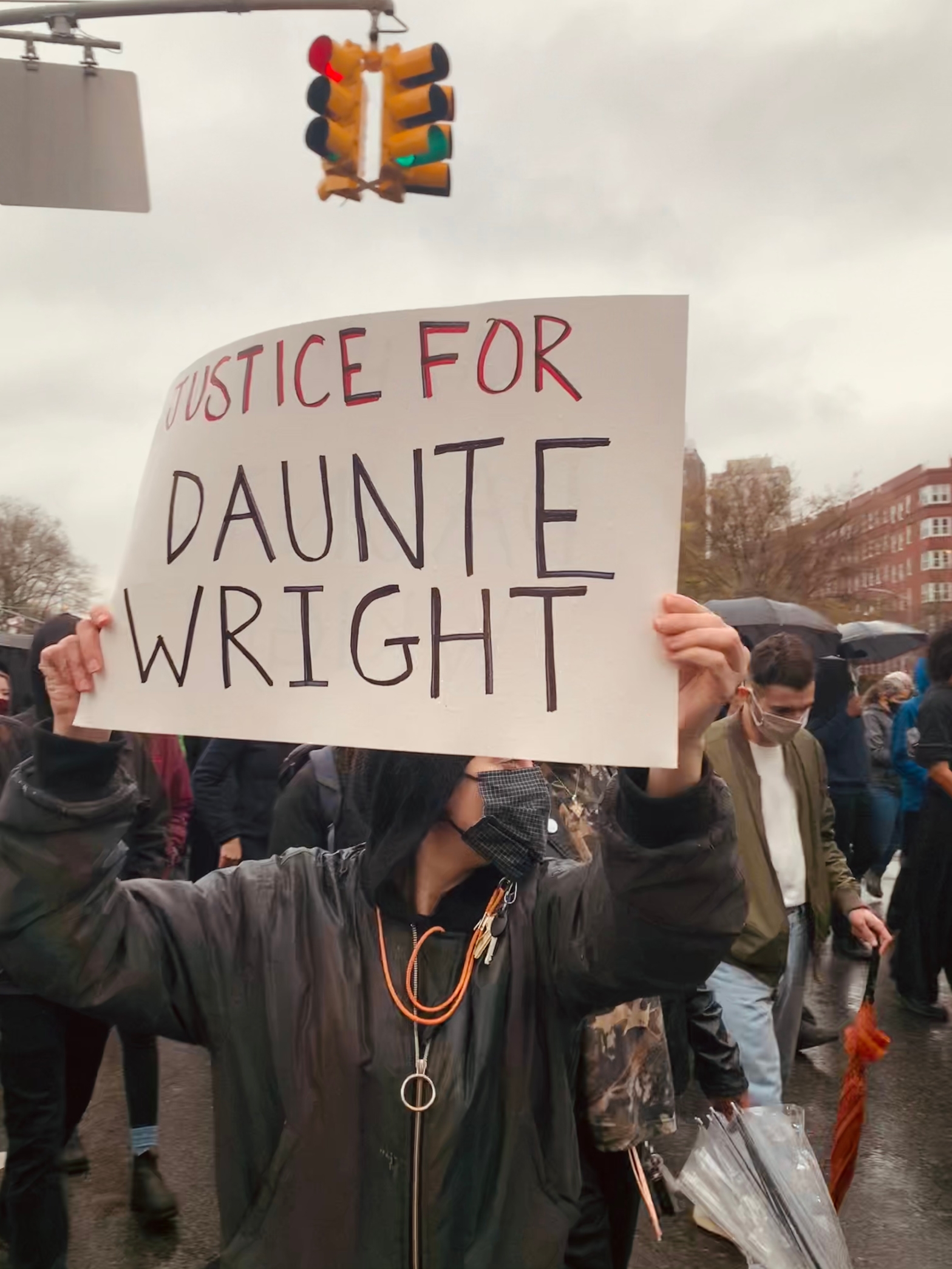by Ashley Rogers
On April 11th, Daunte Wright was murdered by police during a traffic stop in Brooklyn Center, a city bordering Minneapolis, Minnesota. Following last year’s huge wave of protests over George Floyd’s murder at the hands of Minneanapolis police officer Derek Chauvin—who is on trial only ten miles from where Wright was killed—this new murder of another unarmed black man at the hands of police ignited protests almost immediately. Protests began in Brooklyn Center the night of April11th and spread around the country in the next few days, reaching Portland, Chicago, Boston, New York, and other cities. The response to Daunte Wright’s murder could be the start of a return to large-scale demonstrations like last year’s millions-strong Black Lives Matter (BLM) protests.
When the George Floyd protests began, his was not the only name remembered at protest rallies—the movement quickly adopted other ignored victims of racist police brutality, including Ahmaud Arbery, Breonna Taylor, and Jacob Blake. The same is true now with the release of body camera footage of 13-year-old Adam Toledo being shot on March 29th by Chicago police. The video shows Adam Toledo was unarmed, shot with his hands up. The body cam footage was deliberately withheld from the public for weeks by Chicago’s police review board, but the new wave of protests may have pressured the police to release the video.
Unfortunately, the George Floyd protests of last year faded with little to show in terms of meaningful change. Pressure from the Democratic Party and leading figures under the Black Lives Matter banner helped take the movement off the streets and diverted any remaining energy away from protests and into backing the Democratic Party in the 2020 elections. Throwing everything behind Biden and other Democratic Party politicians de-mobilized the mass movement against racism and police brutality. Once the pressure of active BLM and related protests was removed, many demands for reforming and defunding police forces were weakened or disappeared. Biden outright attacked the idea of defunding the police and the Democratic Party opposed many progressive demands against racism and police brutality that emerged out of the BLM movement last summer, including any significant de-funding of the police.
Since Jacob Blake’s shooting on August 25th, 2020, police shootings have continued non-stop, including the murders of Dijon Kizzee, Deon Kay, Ricardo Munoz, Alvin Cole, Casey Goodson, Bennie Edwards, Andre Hill, and Dolal Idd. But reading through the press releases of mainstream anti-racist activist organizations, like the Black Lives Matter Global Network, the focus became less and less on the victims of police brutality and more and more on Biden’s 2020 campaign. By the time the election had passed, the movement was almost entirely gone—and for the entire period from Jacob Blake’s shooting in August to Daunte Wright’s shooting on April 11th, any remaining protests against police shootings were ignored by the Black Lives Matter Global Network in favor of requesting a meeting with the Biden-Harris campaign—a request which, so far, has yet to even be answered.
During the active BLM anti-racist protests last summer, Trump and the Republicans were a focus of intense anger from the movement in the streets. But the movement didn’t stop at just opposing Trump. At least on the grassroots level, including in cities and states controlled by the Democratic Party, the BLM protest movement tended to also attack systemic, institutionalized racism, and in many instances started to make connections to capitalism being the root cause of racism and police repression. Despite this, national BLM leaders and also local leaders, where they emerged, influenced and led the movement off the streets and into supporting the Democratic Party during the election campaigns. This not only took heat off the Trump regime just prior to the election, but it also removed the growing pressure of the BLM movement on cities and states controlled by the Democratic Party, including Minneapolis.
Last year, on May 30th, Trump addressed George Floyd’s death, describing it as a “grave tragedy,” but also stating that he “stands in firm opposition to anyone exploiting this tragedy to loot, rob, attack, and menace.” The response of President Biden on April 12th to Wright’s murder was much the same, describing it as “a really tragic thing,” stating there is “absolutely no justification” for violence or looting, effectively equating loss of human lives with theft of capitalist property! In fact, in a predictable betrayal to the activists and movement he appealed to during his campaign, Biden announced on April 11th—the day of Daunte Wright’s murder—that he won’t be following through on his campaign “promise” to create a national police oversight commission. Biden’s administration is banking on the “George Floyd Justice in Policing Act”—a bill passed in the House last June—being enough of a concession to defuse the anti-racist movement. But Democrats have often been the architects of mass incarceration policies, and have little interest in seriously challenging entrenched police repression in a country where only around one percent of officers responsible for fatal shootings are ever arrested, much less convicted.
We can’t wait for corporate politicians to end racist police killings. As we wrote back in June—discussing the emerging George Floyd protests—to win systemic changes, we’re going to need organization, coordination, and political independence from the corporate political parties. After all, the ruling class—with their police, military, courts and prisons—organize and coordinate with each other to crush working class movements. As Civil Rights activist Malcolm X famously said, “We’re not outnumbered. We’re out organized.” The anti-racist movement needs organizations that can bring together workers and activists to call protests, debate and decide a program of concrete demands for the movement, share resources, coordinate with other movements and organizations, and build a sustained nationwide movement. Anti-racist organizers participating in this new wave of protests should form neighborhood committees of protestors, working people, and youth from the community to create and use the democratic structures needed to decide future actions and tactics, and to develop a program with clear demands to help organize more participation in mass protests and more support in general. All leaders and representatives of these organizations should be elected and also subject to immediate recall if they betray the movement.
Above all, we need a truly mass movement, one that can bridge the divisions drawn between us by capitalism. A multi-racial working class movement, with the crucial involvement of organized labor, is the most powerful tool we have available. It has the strength to force through serious gains for the working class, including demilitarizing and significantly defunding the police, convicting killer cops, ending the war on drugs, subjecting the police to fully democratic community control, fully funding education and public services, and much more. A movement that unites workers and youth against all forms of oppression under capitalism can also begin to take on the common enemy that keeps us all down—the capitalist system.
We don’t think you fight fire with fire best; we think you fight fire with water best. We’re going to fight racism not with racism, but we’re going to fight with solidarity. We say we’re not going to fight capitalism with black capitalism, but we’re going to fight it with socialism. We’ve stood up and said we’re not going to fight reactionary pigs and reactionary state’s attorneys…with any other reactions on our part. We’re going to fight their reactions with all of us people getting together and having an international proletarian revolution.
Fred Hampton
Image Credit: Andrew Ratto via Flickr // (CC BY 2.0)

